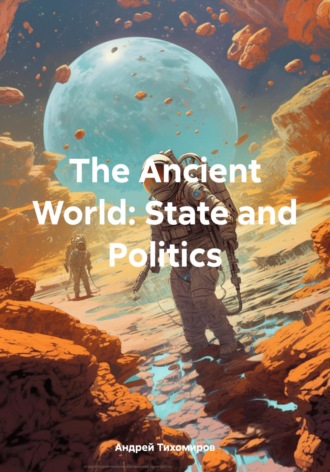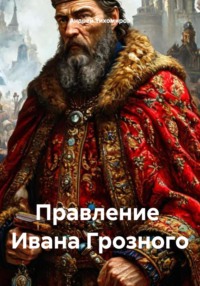
Полная версия
The Ancient World: State and Politics

Андрей Тихомиров
The Ancient World: State and Politics
Introduction
The feudal lords' ownership of land, their exclusive privilege to power, the class division of the population, and subsistence farming were characteristic features of medieval society. However, the political domination of feudal lords in different countries was carried out differently, not to mention the fact that some peoples did not have serfdom of peasants at all. After the collapse of the tribal system, the Germanic and Slavic peoples immediately entered the period of feudalism, bypassing slavery.
Modern Western historians, as a rule, deny the regularity of the historical process, the movement of civilization towards more perfect forms of the political structure of society. In their opinion, the development of history takes place in a closed circle, where the fate of peoples depends primarily on the will of the rulers. Many of them repeat the words of the German philosopher Georg Wilhelm Friedrich Hegel (1770-1831): "The lessons of history are that people do not learn lessons from history."
Private property in every bourgeois society is the main principle of economic and social life, the main institution of civil law. Nevertheless, the unlimited domination of the bourgeoisie is carried out by different methods. The uniformity of states does not exclude the difference in their forms, political regimes, the legal status of social groups, etc. In this regard, for the history of the state and law, the general and special in the organization of the political power of the ruling class in each individual country is of particular interest.
The factors of population, geographical environment, peculiarities of the nation's mental makeup, as well as class, ideological motives of prominent figures had a certain influence on political history. Changes in the strategy and tactics of the ruling class are primarily reflected in the evolution or radical restructuring of state bodies and legislation.
The study of the history of the development of the state system of various countries facilitates the understanding of the system of methods of class domination in a specific historical situation, finds out the reasons for the transition from one political regime to another.
The basic principles of the new government, the organization of management are laid during the period of social revolutions. At the same time, the principles and system of new legislation adapted to the needs of the economic system are created, the political and legal aspirations of classes and social groups of society are revealed. They find expression in constitutions, organic laws, charters, declarations, codes, etc.
The slave-owning system did not remain motionless. In the course of its historical development, it has passed through several successive stages. Early slavery, not yet completely separated from the communal-tribal system, was the basis of the state formations of the Ancient East – such as the Egyptian despotism, the Hittite kingdom, Assyria, Persia, the states of Ancient India. In these military-theocratic powers, relying on the power of non-economic coercion, foreign policy was guided mainly by the interests of conquest: the seizure of land, slaves, livestock, plunder of wealth available in neighboring countries were the main goal of the wars of that time. International issues were usually resolved by armed force. However, the states of the Ancient East had to develop a very lively diplomatic activity. Diplomatic relations were conducted by the tsars themselves. The rulers of the Ancient East were revered as gods, embodied the whole state in their person, had at their disposal whole armies of "royal servants" – officials and scribes.
In accordance with the main objectives of the conquering foreign policy of the military-theocratic kingdoms of the East, their centralized diplomacy resolved a relatively limited range of issues. Its strongest side was the organization of pervasive military and political intelligence.
More developed slavery, associated with commodity-money economy and the growth of coastal cities, was the basis of the ancient states – Greece and Rome.
The foreign policy of these slave-owning city states ("polis") was determined by the interests of the struggle for the expansion of territories, for the acquisition of slaves, for markets. From here
there followed: the desire for hegemony, the search for allies, the formation of groupings, colonial expansion, which aimed at the formation of major powers and caused clashes among the Greeks in the East, with the Persian kingdom, the Romans in the West, with the richest trading republic of the ancient world – Carthage.
The diplomatic activity of the ancient polis was expressed in lively negotiations, the continuous exchange of embassies, the convening of meetings, the conclusion of defensive and offensive allied treaties.
The social system of the ancient Eastern states
The ancient East is one of the first centers of civilization. People learned to domesticate animals here early, learned hoe farming, some crafts. The subtropical climate, fertile soils, and relatively high population density at that time accelerated the process of transition from hunting and fishing to cattle breeding and agriculture. Ancient Indo-Europeans, for example, are formed on the territory of the Southern Urals. The valleys of the rivers Nile, Tigris and Euphrates, Yangtze and Yellow River, Indus and Ganges were especially favorable for agriculture.
In the 5th millennium BC, man for the first time began to use metal for the manufacture of tools, which dramatically increased labor productivity. The prerequisites for obtaining an additional product were created, economic conditions for human exploitation arose. The emergence of private property and property inequality accelerated the disintegration of the tribal organization, and a class society emerged on its ruins.
The slave—owning state is the first historical type of state. With his help, slaves were forced, small farmers and community workers were exploited, and the economic, political and estate interests of the slave-owning class were protected. The emergence of a slave—owning formation is a natural process. Compared to the patriarchal-tribal system, slavery meant progress in the history of mankind.
The formation of a class society in the countries of the Ancient East is a long process, since many remnants of the tribal system have been preserved for centuries. The slave-owning mode of production in the East had peculiar features. The existence of a neighborhood or territorial community hindered its development. The specific historical conditions of each country, the peculiarity of the forms of class struggle, left their mark on the methods of management, on the nature of legislation. But for all their diversity, the ancient Eastern despotisms were the dictatorship of the slave-owning class.
In addition to class uniformity, the socio-economic system of the ancient Eastern peoples had many common features. The low level of technology, its stagnant nature, extremely slow progress in improving tools, the specifics of natural and climatic conditions delayed the collapse of the neighboring (rural) community for several millennia. For the same reasons, the institution of private ownership of land and water was poorly developed.
In the countries of the Ancient East, land and water were initially used by the community, and then became the property of the state. Taking care of irrigation, construction and repair of canals and dams has been the main responsibility of the community since ancient times. We practiced joint, collective work. The deeply natural nature of production, the combination of handicrafts and agriculture within each community, scanty exchange, extreme underdevelopment of commodity-money relations, economic isolation are characteristic features of the ancient Eastern community.
Because of the stability of the community, the ruling class extracted the bulk of the surplus product, exploiting first of all communal peasants, and then slaves.
In the conditions of primitive technology and agriculture associated with irrigation, private ownership of land plots was instilled for a painfully long time. Only a large collective of people from the entire community, and sometimes the entire province, could maintain the irrigation system in order, prevent its destruction during natural disasters, cut down the jungle, protect crops, livestock from wild animals, drain the swamp, dig a deep well, etc. That is why, since ancient times, the community, and then the state, assumed the important economic function of organizing public works related to maintaining the irrigation system in order.
The ancient Babylonian laws of King Hammurabi (XVIII century BC) testify to the preservation of the neighborhood community and remnants of the primitive communal system. According to these laws, if a murderer or robber who committed a crime on the territory of a community was not found, then its residents were obliged to compensate the victim or the treasury. At the same time, the community could claim damages from the person whose fault caused damage to the dam, canal.
The community was no longer as monolithic as before. The laws of Hammurabi mention the existence of communal and private ownership of land. Private land could be sold, donated, communal land could only be leased.
In ancient China, for a long time there was a so-called system of well fields. The plot of arable land was divided into 9 equal fields. From the best part of the field, the harvest was taken in favor of the king (van) or the local ruler. In addition, the community members paid taxes to the treasury with silk, canvas, performed military, construction and horse-drawn duties. Around the middle of the first millennium BC, the well system was replaced by a land tax, the purchase and sale of land began to develop, which finally destroyed the community.
In ancient Egypt, tenants of state, royal, temple land could not leave their plot. The ruling class of slaveholders included: the despot, his relatives and confidants, priests, officials, military nobility, moneylenders, tax collectors, local governors. Priests enjoyed great influence in ancient Egypt, eunuchs and learned monks in ancient China, and priests and warriors (brahmins and kshatriyas) in ancient India.
The income of the nobility consisted of the salary paid to them by the tsar, and income from their own economy. The class solidarity of priests and officials was a prerequisite for their preservation of their dominance.
In addition to the ruling class of slaveholders, there was the largest part of the population – residents of rural communities, farmers, community members. They were the main producer of material goods. Free farmers and artisans carried various duties, paid taxes to the royal treasury and the local nobility, usually in kind (grain, rice, cattle, oil, etc.). A militia was usually formed from them.
The labor of a free man has not yet been supplanted by the labor of slaves. In ancient Babylon, in addition to the free, avilum and mushkenum, there was a category of serving people, soldiers and officials (redu and bairu), who were given plots of land with a house and garden for their service. This property was called ilku. The owner of ilku could not sell it, give it away. His property was, in principle, inalienable. With the termination of service, it was withdrawn to the treasury. But if the son of the previous owner continued to perform the duties of his father, the property was not taken away. The owner of the ilku was punishable by death for not showing up for service.
The situation of slaves in the countries of the Ancient East was less difficult compared to the situation of slaves in ancient Greece and Rome. Royal and temple slaves could have small property, a family, sometimes the law gave them some legal protection. According to their social status, slaves stood between persons and things. Nevertheless, the bulk of the slaves were absolutely disenfranchised. The property right of the slaveholder was heavily protected by law.
Slaves were most often exploited on the royal lands; they performed the duties of servants for the major nobility, officials and priests, etc. There was also domestic slavery. The main source of replenishment of the number of slaves was military captivity, debt bondage existed almost everywhere. Slaves were bought and sold in the market. Forced people were transferred by will along with other property. The capture of prisoners to sell them into slavery was one of the main incentives for military campaigns. Slaves were often killed in sacrifices. After the death of the king, his servants-slaves were killed and laid next to his tomb. The children of slaves were considered slaves. For killing someone else's slave, a fine was usually paid to his master. Slaves engaged in agriculture, handicraft, sometimes could have their own family. Over time, in some states, slaves began to be given plots of land for temporary use.
In ancient Egypt, slaves were considered the property of the state. The murder of a slave was regarded as damage to state property. Pharaoh gave slaves to temples, important officials.
The ancient Eastern states, by their class essence, belong to the slave-owning type. The main functions of these states were the suppression of the oppressed masses, the defense of the country, the seizure of neighboring lands and the organization of public works. With the help of the priests, the ideological enslavement of the oppressed masses was carried out.
The most common form of government was despotism, a bureaucratic monarchy, strictly centralized, with a large administrative apparatus. The economic basis of the despot's power was state ownership of land, taxes, captured loot during wars. Unlimited tsarist power was based on an army, sometimes hired, on an extensive, centralized apparatus of officials. Under bureaucratic centralism, governance was based on complete and unconditional subordination up the vertical; any disobedience, disobedience to the tsar and the nobles was punishable by death. In the countries of the Ancient East, the royal power, as a rule, was deified. The orders of the despot were equated with divine decrees.
However, the relatively small territory of these countries affected the structure of the state apparatus. The court was not separated from the administration.
Having unlimited power, the despot considered the interests of the upper nobility, fulfilled the will of the ruling class of slaveholders. A despot could not stay in power if he did not enjoy the support of the ruling class, did not rely on the army, bureaucracy, priesthood. The head of state in the countries of the Ancient East was called differently: in Ancient Egypt – Pharaoh, in Babylon – Ancient Mesopotamia – lugal or patesi, in China – wang, in India – raja.
The most typical ancient Eastern despotism existed in ancient Egypt. The history of the ancient Egyptian state is divided into 4 major periods: the ancient kingdom – from the end of the fourth to the middle of the second millennium BC, the middle – to the middle of the XVII century BC, the new – to the middle of the XV century BC, later – to the I century BC.
In ancient Egypt, the power of the pharaoh was unlimited, he himself was considered a person of divine origin, the son of the Sun. His name couldn't be said out loud. Pharaoh means "high house". In an official address to him, he should have been called in the third person. The decisions of the Pharaoh on management, finance, command of the army, and the court had the highest force. He appointed his own successor. Colossal pyramid tombs were built for him, the construction of which was carried out for decades and took away the main material and human resources of the country.
Конец ознакомительного фрагмента.
Текст предоставлен ООО «Литрес».
Прочитайте эту книгу целиком, купив полную легальную версию на Литрес.
Безопасно оплатить книгу можно банковской картой Visa, MasterCard, Maestro, со счета мобильного телефона, с платежного терминала, в салоне МТС или Связной, через PayPal, WebMoney, Яндекс.Деньги, QIWI Кошелек, бонусными картами или другим удобным Вам способом.









